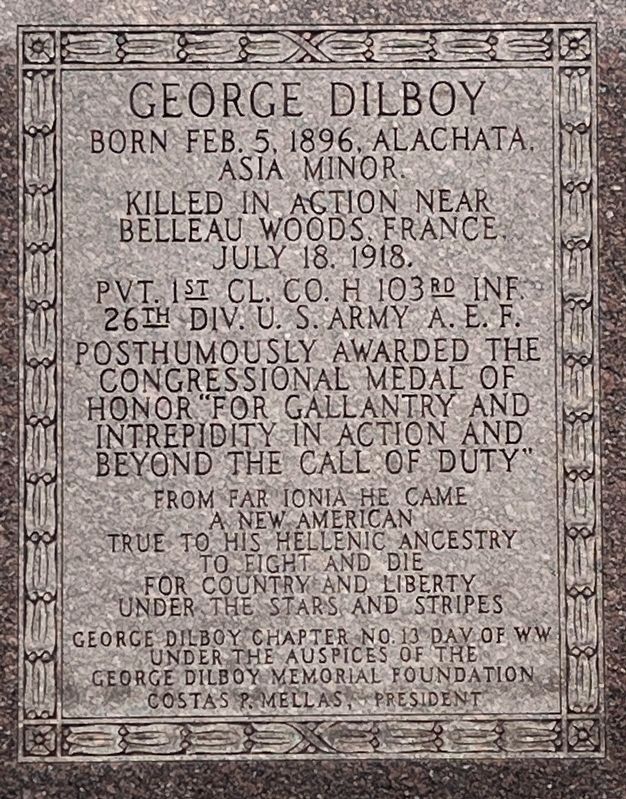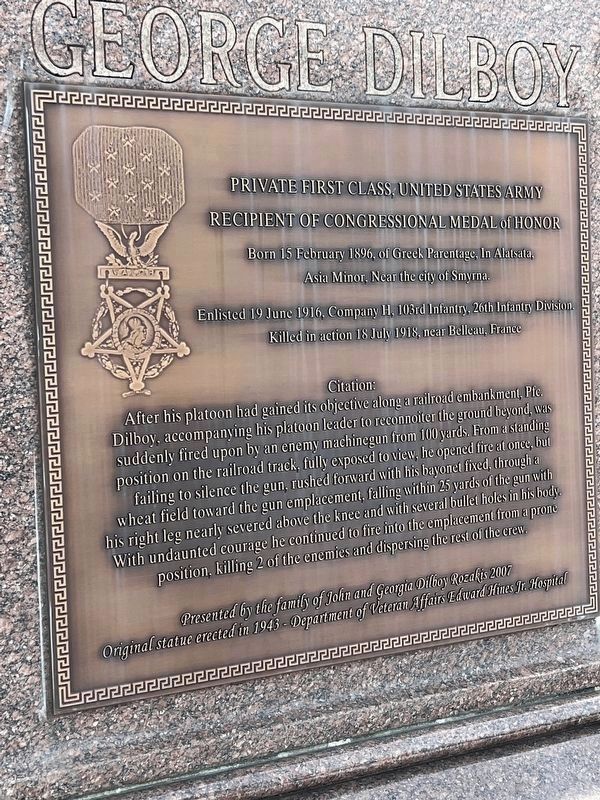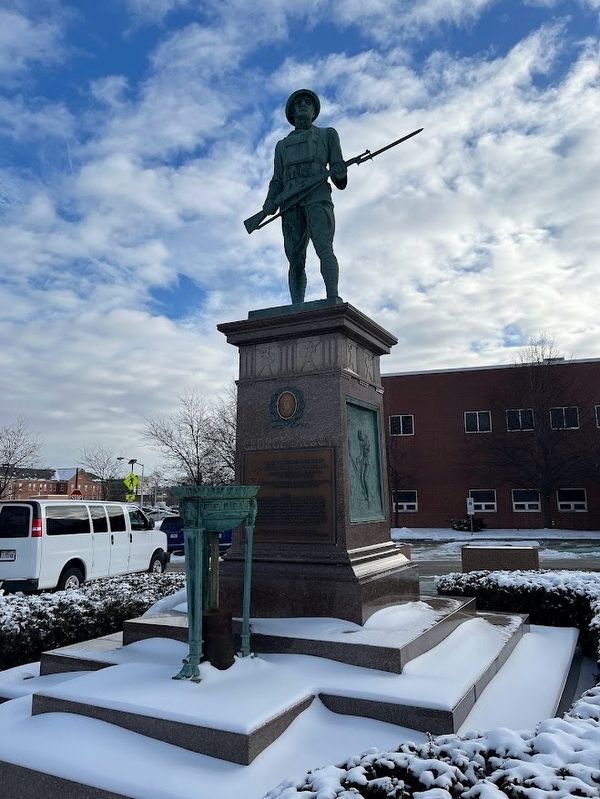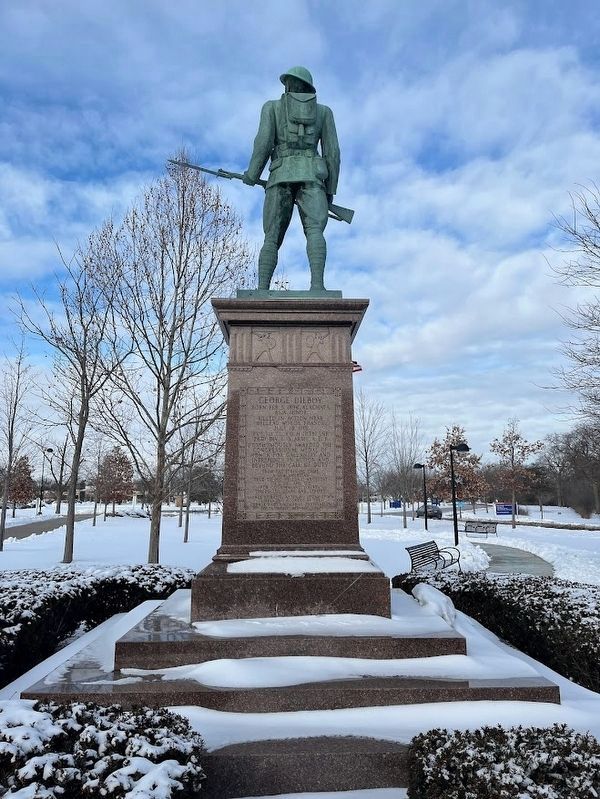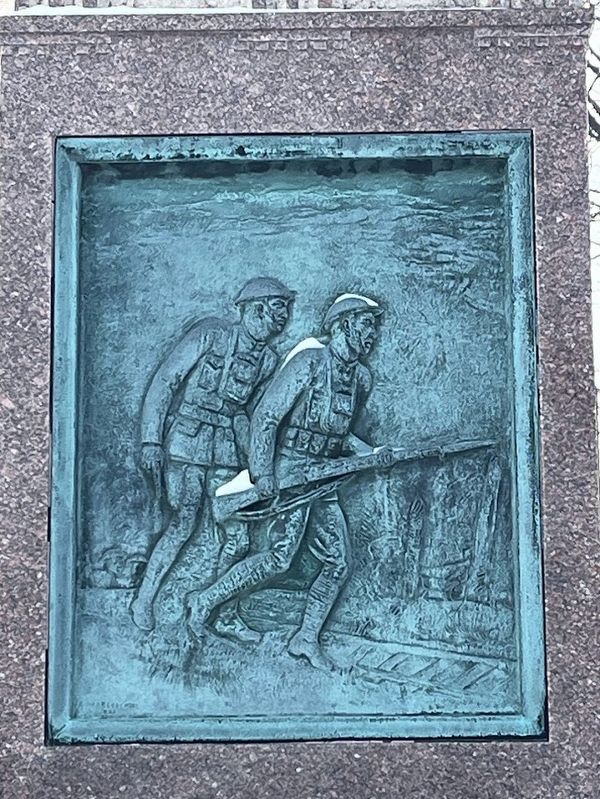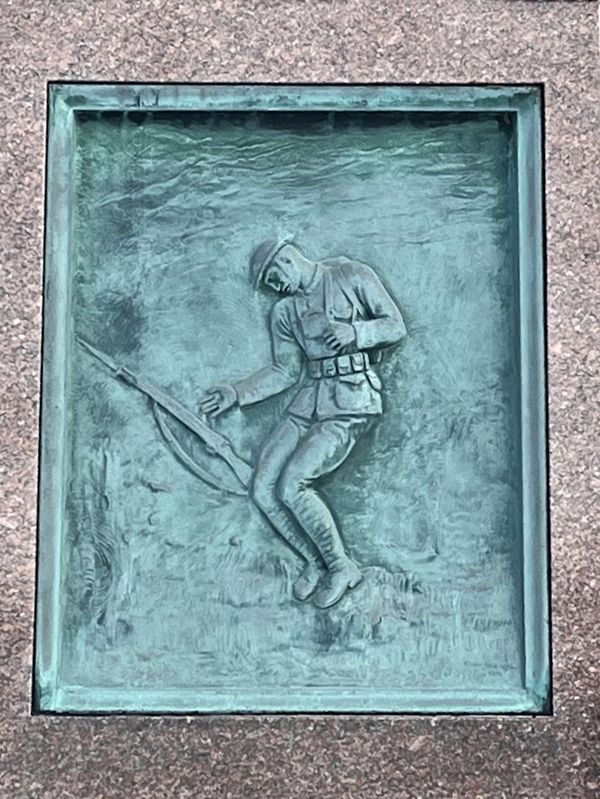Hines in Cook County, Illinois — The American Midwest (Great Lakes)
George Dilboy
Private First Class, United States Army
— Recipient of Congressional Medal of Honor —
Asia Minor.
Killed in action near
Belleau Woods, France
July 18, 1918.
Pvt. 1st Cl. Co. H 103rd Inf.
26th Div. U.S. Army A.E.F.
Posthumously awarded the
Congressional Medal of
Honor "for gallantry and
intrepidity in action and
beyond the call of duty"
From far Ionia he came
a new American
true to his Hellenic ancestry
to fight and die
for country and liberty
under the stars and stripes
Born 15 February 1896, of Greek Parentage, In Alatsata, Asia Minor, Near the city of Smyrna.
Enlisted 19 June 1916, Company H, 103rd Infantry, 26th Infantry Division.
Killed in action 18 July 1918, near Belleau, France
Citation: After his platoon had gained its objective along a railroad embankment, Pfc. Dilboy, accompanying his platoon leader to reconnoîter the ground beyond, was suddenly fired upon by an enemy machinegun from 100 yards. From a standing position on the railroad track, fully exposed to view, he opened fire at once, but failing to silence the gun, rushed forward with his bayonet fixed, through a wheat field toward the gun emplacement, falling within 25 yards of the gun with his right leg nearly severed above the knee and with several bullet holes in his body. With undaunted courage he continued to fire into the emplacement from a prone position, killing 2 of the enemies and dispersing the rest of the crew.
Erected 1942 by George Dilboy Memorial Foundation; Disabled American Veterans of the World War, George Dilboy Chapter #13.
Topics and series. This memorial is listed in these topic lists: Immigration • Patriots & Patriotism • War, World I. In addition, it is included in the Medal of Honor Recipients series list.
Location. 41° 51.69′ N, 87° 50.376′ W. Marker is in Hines, Illinois, in Cook County. Memorial is on Tripp Avenue, 0.2 miles south of Roosevelt Road, on the right when traveling south. The marker is on the campus of Hines VA Hospital, across the street from the Blind Center, building 113 on the hospital's campus. Touch for map. Marker is at or near this postal address: 5000 South 5th Avenue, Hines IL 60141, United States of America. Touch for directions.
Other nearby markers. At least 8 other markers are within walking distance of this marker. Veterans Memorial (within shouting distance of this marker); Veterans Honor Roll (approx. ¼ mile away); World War I Memorial Fountain (approx. ¼ mile away); a different marker also named Veterans Memorial (approx. half a mile away); Forest Home Cemetery Veterans Flagpole (approx. ¾ mile away); Columbia Post No. 706 (approx. ¾ mile away); Phil Sheridan G.A.R. Post No. 615 Memorial (approx. 0.8 miles away); Native Prairie Plants (approx. one mile away). Touch for a list and map of all markers in Hines.
More about this marker. The rear plaque was added to the statue in 2007, "presented by John and Georgia Dilboy Rozakis." Like George, Georgia was born in Alatsata and appears to be a relative of his. She emigrated to Massachusetts in 1928 at age 19 and died in 2002.
Although the plaque says that the statue dates to 1943, other sources—including a dedication plaque obscured by snow when the statue was visited in January 2024—points to May 24, 1942 as the dedication date.
Regarding George Dilboy. Dilboy was born in Alatsata (also Alachata or Alaçatı), a city near the eastern side of the Aegean Sea that was at that point a part of the Ottoman Empire and now is part of Turkey, to parents of Greek descent. His father moved to Somerville, Massachusetts, in 1908 and George joined him two years later, at age 12. In 1912, George returned to Greece to fight for the Hellenic Army in the First and Second Balkan Wars. Returning to the U.S. after those wars, Dilboy enlisted in the New Hampshire National Guard to fight in the conflict on the Mexican border, and then, when the U.S. entered World War I, he enlisted in the U.S. Army and fought in the Champagne-Marne defensive and the Aisne-Marne counter-offensive. The plaque on the statue describes the heroic actions that led to both his death and the Congressional Medal of Honor—believed to be the first awarded to a Greek-American.
Dilboy was first interred in Aisne-Marne American Cemetery in France. In 1922, at the behest of his family, his remains were disinterred and sent to Alatsata, which had returned (briefly it turned out) to Greek hands. But Turkish troops regained possession of the city and the church where he would be buried, scattering his bones. Soon thereafter, a special Naval task force was sent to Turkey to take possession of Dilboy's remains and return them to the U.S.; Turkey officially apologized for the incident. Dilboy was re-interred in Arlington National Cemetery in 1923, with President Coolidge presiding over his burial.
George Dilboy had no direct connection to the Hines VA Hospital (which opened a few years after World War I and is named after a local casualty of World War I), nor to the Chicago
area—other than the city's large and active Greek population. Dilboy is also honored in and near Somerville, Massachusetts, where lived. A bust of Dilboy sits in front of Somerville's city hall, and that city's local VFW chapter is also named after him. There is also a Dilboy Field, a recreational park, in West Somerville.
Related marker. Click here for another marker that is related to this marker. George Dilboy
Also see . . . Private George Dilboy, One of the Ten Greatest Heroes of World War I.
From the Congressional Medal of Honor Society: "In later years, Colonel S. M. Shumway, his company commander, wrote: 'It was one of the most impressive sights I experienced in the War. George Dilboy died facing the enemy, carrying on as long as there was the faintest whiff of breath in his body. He routed the enemy alone. He was as fine a soldier as ever served under the Stars and Stripes.'"(Submitted on January 20, 2024, by Sean Flynn of Oak Park, Illinois.)
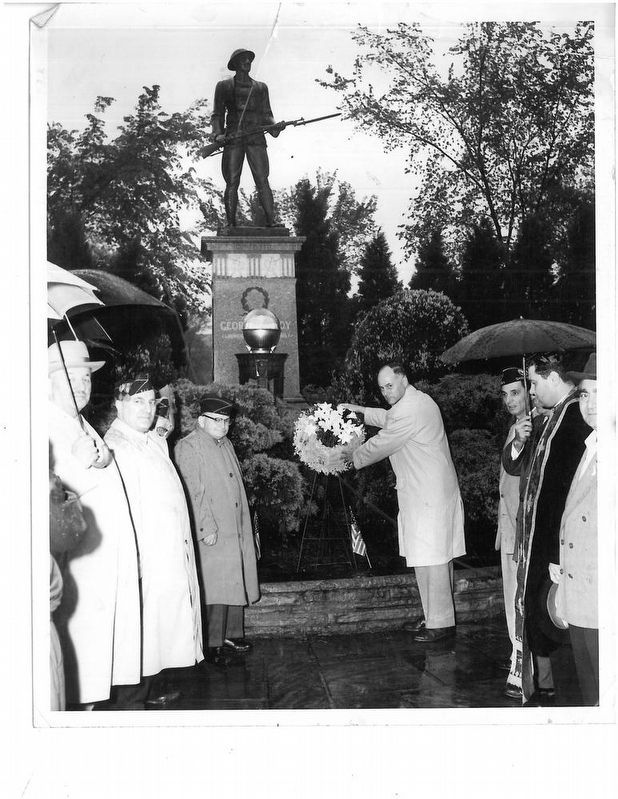
Courtesy of the National Hellenic Museum, May 24, 1942
7. George Dilboy Statue dedication, May 24, 1942
Description from the National Hellenic Museum in Chicago: "Black and white photo of a group of 31 men and women gathered in front of the George Dilboy Memorial. They stand in a semi-circle in three rows. The memorial consists of a bronze life-size sculpture of a man wearing a World War I Army uniform and steel helmet, atop a tall concrete pedestal. The figure stands with feet apart, holding a rifle horizontally in front of his waist. Several feet of the pedestal are visible above the people standing below. It has Greek architectural motifs, including a frieze at the top with two Greek warriors separated by triglyphs. Below the frieze is a laurel, and below that 'George Dilboy' is etched in all caps. To the right of the memorial is a flag with the number '13' hanging on an eagle-topped pole (Charter #13 of the Disabled Veterans of the World War funded the George Dilboy Memorial). At the left of the group is an American flag, also hanging on a pole with an eagle at the top. There are rows of trees in the near background. In each foreground corner is a patch of tulips and a small American flag stuck into the grass on a pole. A concrete bench extends from the left edge of the image. Several of the people in the group wear garrison caps with veteran's insignia. One of these men, in the front row at left, holds a trumpet. All of the men wear dress suits. Directly right of the memorial, in the front row, is a priest wearing a liturgical stole. In the backrow, closest to the memorial, are five women, two of whom wear garrison caps."
Credits. This page was last revised on January 23, 2024. It was originally submitted on January 20, 2024, by Sean Flynn of Oak Park, Illinois. This page has been viewed 50 times since then. Photos: 1, 2, 3, 4, 5, 6, 7. submitted on January 20, 2024, by Sean Flynn of Oak Park, Illinois.
